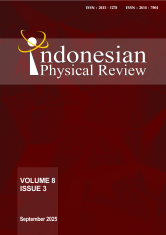LANDSLIDE AREA MAPPING IN DAMPIT SUBDISTRICT, MALANG DISTRICT, EAST JAVA PROVINCE USING SATELLITE IMAGERY OF GRAVITY DATA FOR DISASTER MITIGATION
Authors
Muwardi Sutasoma , Adi Susilo , Sukir Maryanto , Faridha Aprilia , Mayang Bunga Puspita , Mohammad Habibiy Idmi , Muhammad Fathur Rouf Hasan , Agung Teguh Wibowo Almais , Sri HerwiningsihDOI:
10.29303/ipr.v8i3.487Published:
2025-06-17Issue:
Vol. 8 No. 3 (2025)Keywords:
Landslide, Satelite Imagery, Gravity, DampitArticles
Downloads
How to Cite
Abstract
Research using satellite imagery of gravity data has been conducted in the Dampit District, Malang Regency, East Java Province. This research was conducted to identify areas vulnerable to landslides. The results of this research can serve as a basis for the government to develop effective landslide disaster mitigation policies, thereby minimizing the losses incurred. The data used is TOPEX satellite gravity data in the form of Free Air Correction data, and supported by landslide vulnerable areas data from the InaRisk satellite. The research area is 23 km x 16 km with 2 km spacing between points and 184 measurement points. Furthermore, the research area is divided into four areas: Area A1, Area A2, Area A3, and Area A4. The residual anomaly value in the study area is between 82.7 mGal to 142.4 mGal. The residual anomalies are more variable due to the local nature of the anomalies. The correlation between the residual anomaly value and InaRisk satellite image data shows that Area A4 is the most vulnerable to landslides, especially if there is a trigger such as an earthquake. This is because Area A4 has a low-density value, a large fault, and is the contact area between the Mandalika Formation and Wuni Formation.References
M. T. Chaudhary and A. Piracha, “Natural disasters—origins, impacts, management,” Encyclopedia, vol. 1, no. 4, pp. 1101–1131, 2021, [Online].
P. Lemenkova, “Analysis of the difference in depths and variation in slope steepness of the Sunda Trench, Indonesia, east Indian Ocean,” Rev. Geomorfol., vol. 22, no. 1, pp. 21–41, 2020.
BNPB, “Tentang InaRISK (About InaRISK) [online],” 2023. [Online]. Available: https://inarisk.bnpb.go.id/about#:~:text=InaRISK adalah portal hasil kajian,terintegrasi dengan realisasi pelaksanaan kegiatan accessed at 25 January 2025 at 23:17 WIB.
H. S. Naryanto, H. Soewandita, D. Ganesha, F. Prawiradisastra, and A. Kristijono, “Analisis Penyebab Kejadian dan Evaluasi Bencana Tanah Longsor di Desa Banaran, Kecamatan Pulung, Kabupaten Ponorogo, Provinsi Jawa Timur Tanggal 1 April 2017,” J. Ilmu Lingkung., vol. 17, no. 2, p. 272, 2019.
S. Bachri, R. P. Shrestha, F. Yulianto, S. Sumarmi, K. S. B. Utomo, and Y. E. Aldianto, “Mapping landform and landslide susceptibility using remote sensing, gis and field observation in the southern cross road, Malang regency, East Java, Indonesia,” Geosciences, vol. 11, no. 1, p. 4, 2020, [Online].
BPBD Kabupaten Malang, “Bupati bersama Wabup Malang Tinjau Tanah Longsor di Kecamatan Dampit.” [Online]. Available: https://bpbd.malangkab.go.id/content/malangkab-pusat-opd-bupati-bersama-wabup-malang-tinjau-tanah-longsor-di-kecanatan-dampit diakses Tanggal 02 Maret 2025 Pukul 09.35
M. Sutasoma, A. Susilo, and E. A. Suryo, “Penyelidikan Zona Longsor dengan Metode Resistivitas dan Analisis Stabilitas Lereng untuk Mitigasi Bencana Tanah Longsor,” Indones. J. Appl. Phys., vol. 7, no. 1, p. 35, 2017.
S. T. McColl, “Landslide causes and triggers,” in Landslide hazards, risks, and disasters, Elsevier, 2022, pp. 13–41. [Online].
A. Haryono, S. Supriyanto, D. Djayus, M. Mislan, P. Lepong, and A. Y. P. Abbas, “Study of Soil Stratification in Landslide Areas on Bantuas Road Using the Resistivity Geoelectric Method,” Indones. Phys. Rev., vol. 7, no. 1, pp. 133–142, 2024.
C. Li, J. Yan, J. Wu, G. Lei, L. Wang, and Y. Zhang, “Determination of the embedded length of stabilizing piles in colluvial landslides with upper hard and lower weak bedrock based on the deformation control principle,” Bull. Eng. Geol. Environ., vol. 78, pp. 1189–1208, 2019, [Online].
M. A. Akbar, S. R. Utami, and C. Agustina, “Simulasi Pengukuran Longsor Pada Kemiringan Lereng Dan Ketebalan Seresah Yang Berbeda,” J. Tanah dan Sumberd. Lahan, vol. 9, no. 2, pp. 321–327, 2022.
D. M. Adfy and M. Marzuki, “Analisis Kerawanan Bencana Longsor dari Karakteristik Hujan, Pergerakan Tanah dan Kemiringan Lereng di Kabupaten Agam,” J. Fis. Unand, vol. 10, no. 1, pp. 8–14, 2021.
E. M. Rahayu and A. Syarifuddin, “Edukasi Pendekatan Vegetatif dalam Upaya Pencegahan Longsor di Desa Sukomulyo Kecamatan Pujon Kabupaten Malang,” Inov. J. Pengabdi. Masy., vol. 2, no. 3, pp. 465–472, 2024.
R. Sawitri, D. Baco, R. Ulfiyana, and T. Karo-karo, “Aplikasi Citra Landsat untuk Pemetaan Daerah Rawan Longsor di Kabupaten Bandung,” J. Geosains dan Remote Sens., vol. 2, no. 2, pp. 65–73, 2021.
G. Rickardo and N. Marcelo, “Criteria for specifying rocks in facades,” World J. Adv. Res. Rev., vol. 20, no. 1, pp. 1187–1195, 2023.
A. Jaafari, “An Overview of Triggering and Causing Factors of Landslides,” Landslides Himal. Reg. Risk Assess. Mitig. Strateg. Sustain. Manag., pp. 25–45, 2024.
M. Sutasoma, A. Susilo, Sunaryo, E. A. Suryo, and S. Minardi, “Analysis of the Rock Layer Contact Using the Gravity Data of Satellite Imagery and Resistivity Method,” Int. J. GEOMATE, vol. 23, no. 96, pp. 69–76, 2022.
A. T. Alaydrus, A. Susilo, S. Minardi, A. Naba, and A. Mudyanto, “Identification of Seawater Intrusion Using Geophysical Methods in the Mandalika, Lombok, Indonesia,” Int. J. GEOMATE, vol. 23, no. 97, pp. 12–21, 2022.
M. F. R. Hasan et al., “Mapping of Landslide Potential in Payung, Batu City, Indonesia, Using Global Gravity Model Plus (GGMplus) Data as Landslide Mitigation,” Iraqi Geol. J., pp. 159–168, 2024, [Online].
A. Susilo, E. A. Suryo, F. Fitriah, M. Sutasoma, and Bahtiar, “Preliminary study of landslide in Sri Mulyo, Malang, Indonesia using resistivity method and drilling core data,” Int. J. GEOMATE, vol. 15, no. 48, pp. 161–168, 2018.
A. Susilo, A. M. Juwono, F. Aprilia, F. Hisyam, S. Rohmah, and M. F. R. Hasan, “Subsurface Analysis Using Microtremor and Resistivity to Determine Soil Vulnerability and Discovery of New Local Fault,” Civ. Eng. J., vol. 9, no. 9, pp. 2286–2299, 2023.
B. A. Sadjab et al., “Identifikasi sebaran dan Jenis Sesar Berdasarkan Analisis Data Anomali Gravitasi Topex Provinsi Maluku Utara Lembar Pulau Halmahera Utara,” J. Fis. Flux J. Ilm. Fis. FMIPA Univ. Lambung Mangkurat, vol. 19, no. 2, p. 135, 2022.
A. D. Maulana and D. A. Prasetyo, “Analisa Matematis Pada Koreksi Bouguer Dan Koreksi Medan Data Gravitasi Satelit Topex Dan Penerapan Dalam Geohazard Studi Kasus Sesar Palu Koro, Sulawesi Tengah,” J. Geosaintek, vol. 5, no. 3, p. 91, 2019.
I. K. Dewi, F. Puspitasari, N. M. Z, and A. Martha, “3D Data Gravity Modeling for Identification of the Formation Structure of the Hydrocarbon Basin in the Bajubang Region, Jambi Province,” JGE (Jurnal Geofis. Eksplorasi), vol. 6, no. 3, pp. 216–227, 2020.
F. A. dan S. Kurniawan, “Pemanfaatan Data Anomali Gravitasi Citra GEOSAT dan ERS-1 Satellite untuk Memodelkan Struktur Geologi Cekungan Bentarsari Brebes,” Indones. J. Appl. Phys., vol. 2, no. 2, p. 188, 2012.
R. C. dan R. B. Sujanto, R. Hadisantono, Kusnama, Peta Geologi Lembar Turen. Bandung: Pusat Penelitian dan Pengembangan Geologi., 1992.
M. Sutasoma, A. Susilo, Sunaryo, Sarjiyana, R. H. D. Cahyo, and E. A. Suryo, “Identification of Rock Layer Contacts in the Surrounding of the Sutami Dam Using Geomagnetic Methods,” Int. J. GEOMATE, vol. 21, no. 84, pp. 188–193, 2021.
W. M. Telford, W. M. Telford, L. P. Geldart, and R. E. Sheriff, Applied geophysics. Cambridge university press, 1990.
A. D. Maulana and D. A. Prasetyo, “TOPEX DALAM PENENTUAN KONDISI GEOLOGI STUDI KASUS SESAR PALU KORO , SULAWESI,” vol. 5, no. 3, pp. 91–100, 2019.
F. Luo, J. Yan, C. Zhang, and G. Fu, “Comparison of the Bouguer reduction approach of with satellite gravity data: case study of the eastern Tibetan Plateau and its adjacent areas,” G eofizika, vol. 37, no. 2, pp. 237–261, 2020, [Online].
BNPB, Indeks Resiko Bencana Indonesia Tahun 2022. 2022. [Online]. Available: https://inarisk.bnpb.go.id/pdf/BUKU IRBI 2022.pdf diakses Tanggal 02 Maret 2025 Jam 09.45 WIB.
Wasis, Sunaryo, and A. Susilo, “Perunutan Jalur Sesar Lokal di Desa Sri Mulyo Kecamatan Dampit Kabupaten Malang Berdasarkan Data Geofisika,” Nat. B, vol. 1, no. 1, 2011.
L. Alyazahari, L. A. Wicaksono, and D. Nurtanto, “Perencanaan Perkuatan Lereng Menggunakan Geoframe di Jalan Raya Dampit-Lumajang,” Bentang J. Teor. dan Terap. Bid. Rekayasa Sipil, vol. 10, no. 1, pp. 59–68, 2022.
License

This work is licensed under a Creative Commons Attribution-NonCommercial-ShareAlike 4.0 International License.
Authors who publish with Indonesian Physical Review Journal, agree to the following terms:
- Authors retain copyright and grant the journal right of first publication with the work simultaneously licensed under a Creative Commons Attribution-ShareAlike 4.0 International Licence (CC BY SA-4.0). This license allows authors to use all articles, data sets, graphics, and appendices in data mining applications, search engines, web sites, blogs, and other platforms by providing an appropriate reference. The journal allows the author(s) to hold the copyright without restrictions and will retain publishing rights without restrictions.
- Authors are able to enter into separate, additional contractual arrangements for the non-exclusive distribution of the journal's published version of the work (e.g., post it to an institutional repository or publish it in a book), with an acknowledgment of its initial publication in Indonesian Physical Review Journal.
- Authors are permitted and encouraged to post their work online (e.g., in institutional repositories or on their website) prior to and during the submission process, as it can lead to productive exchanges, as well as earlier and greater citation of published work (See The Effect of Open Access).
















